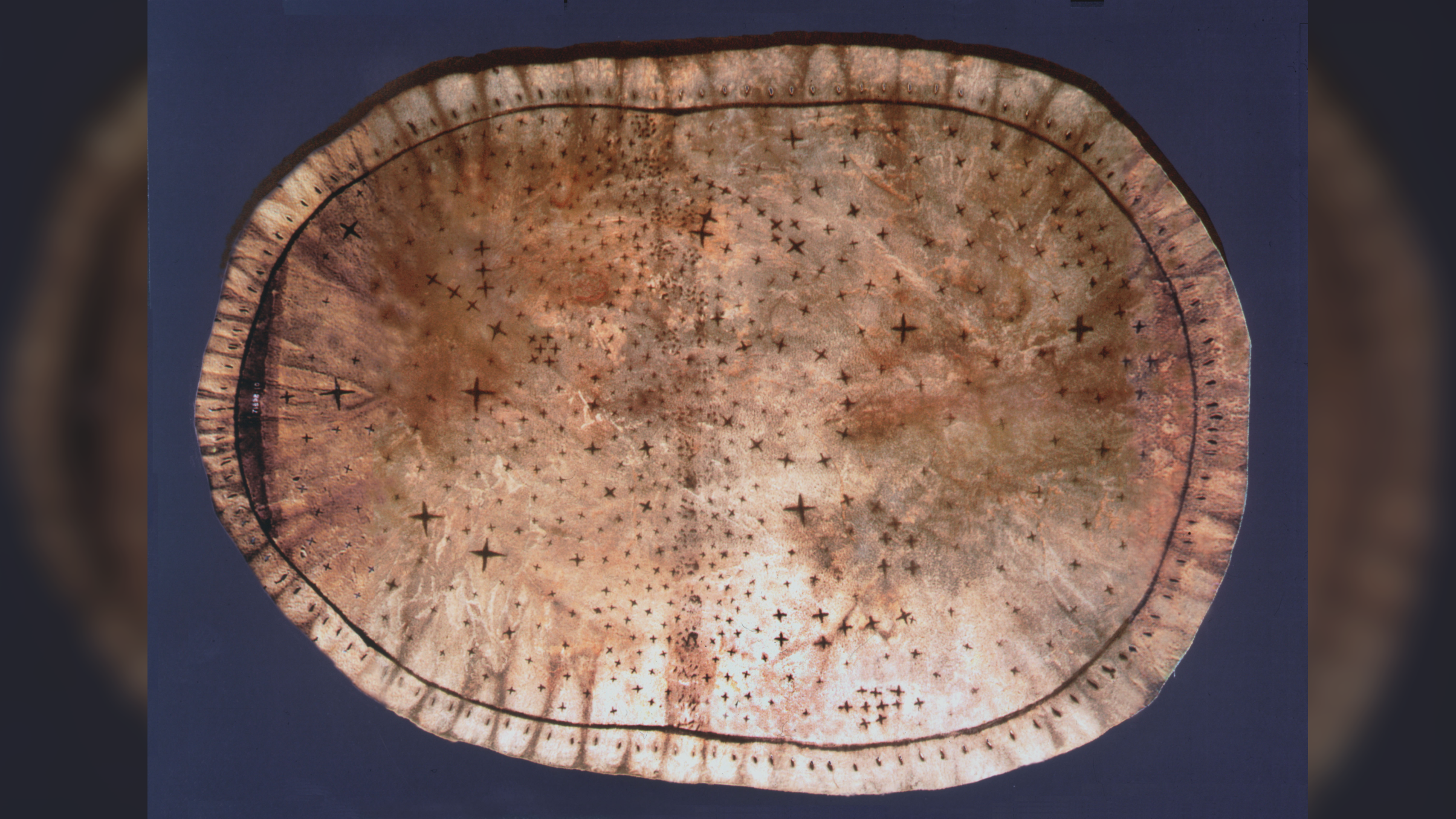Pawnee Star Chart: A precontact elk-skin map used by Indigenous priests to tell an origin story
By Kristina Killgrove
Copyright livescience

Skip to main content
Close main menu
Live Science
Sign up to our newsletter
View Profile
Search Live Science
Planet Earth
Archaeology
Physics & Math
Human Behavior
Science news
Life’s Little Mysteries
Science quizzes
Newsletters
Story archive
COVID vaccine poll
Ant clones members of another species
JWST takes best image yet
Scientists create 6G chip
Science history: Gravitational waves detected
Don’t miss these
Archaeology
‘A truly unprecedented discovery’: 3,000-year-old multicolored mural with fish, stars and gods discovered in Peru
Archaeology
‘Such caves weren’t used for ordinary living’: Rare finger grooves from ancient peoples found in glittering Australian cave
Archaeology
Vounous Bowl: A 4,000-year-old basin holding 4 miniature cows and 18 people — that was buried for mysterious reasons in a Bronze Age tomb in Cyprus
Archaeology
40,000-year-old mammoth tusk boomerang is oldest in Europe — and possibly the world
Archaeology
Evidence is building that people were in the Americas 23,000 years ago
Ancient Egyptians
Sabu Disk: A mysterious 5,000-year-old Egyptian stone sculpture that looks like a hubcap
Archaeology
Penguin Vessel: 1,600-year-old Nazca depiction of a cold-water Humboldt penguin that lives in tropical Peru
‘Fighting dragons’ light up little-known constellation in the Southern sky: Space photo of the week
Archaeology
2,300-year-old arm tats on mummified woman reveal new insights about tattooing technique in ancient Siberia
Archaeology
350-year-old mummified head from Bolivia isn’t what it seems
James Webb telescope’s ‘starlit mountaintop’ could be the observatory’s best image yet — Space photo of the week
Roman dodecahedron: A mysterious 12-sided object that has baffled archaeologists for centuries
Oops! Earendel, most distant star ever discovered, may not actually be a star, James Webb Telescope reveals
A ‘new star’ has exploded into the night sky — and you can see it from North America
Scientists may have found a powerful new space object: ‘It doesn’t fit comfortably into any known category’
Archaeology
Pawnee Star Chart: A precontact elk-skin map used by Indigenous priests to tell an origin story
Kristina Killgrove
15 September 2025
The unique map depicts patterns of stars in the night sky, but its meaning is debated.
When you purchase through links on our site, we may earn an affiliate commission. Here’s how it works.
It’s unclear why Indigenous Americans made the buckskin chart of the night sky.
(Image credit: Werner Forman / Getty Images)
QUICK FACTS
Name: Pawnee Star Chart
What it is: A depiction of the night sky on elk skin
Where it is from: Central Plains (Nebraska and Kansas), United States
When it was made: Circa 1625
The Pawnee Star Chart is a series of crosses sprinkled around an oval piece of elk skin. Likely made in the early 17th century by the Skiri (also called the Skidi) band of the Pawnee Nation, the chart is a fairly accurate representation of the night sky, but the meaning of the chart is still debated.
According to amateur astronomer Ralph Buckstaff, who published a study about the chart in 1927, it was discovered in a sacred bundle in 1902 by Skiri anthropologist James Murie, who passed it on to the Field Museum in Chicago. At the time, the chart was estimated to be at least 300 years old. The piece of tanned elk skin measures roughly 15 by 22 inches (38 by 56 centimeters), and hand-drawn stars cover the surface.
Buckstaff interpreted the chart as a depiction of the night sky, separated into two halves by a centerline of very small stars possibly representing the Milky Way. On the left side, the stars line up into Northern Hemisphere winter constellations, while the right side features summer constellations. This suggested to Buckstaff that the Pawnee recognized the seasonal shift of the stars.
You may like
‘A truly unprecedented discovery’: 3,000-year-old multicolored mural with fish, stars and gods discovered in Peru
‘Such caves weren’t used for ordinary living’: Rare finger grooves from ancient peoples found in glittering Australian cave
Vounous Bowl: A 4,000-year-old basin holding 4 miniature cows and 18 people — that was buried for mysterious reasons in a Bronze Age tomb in Cyprus
Although Buckstaff attempted to show that the Pawnee identified star patterns like the Pleiades and Ursa Minor in the same way as European astronomers did, this claim was refuted by astronomer Von Del Chamberlain in his 1982 book “When Stars Came Down to Earth: Cosmology of the Skidi Pawnee Indians of North America” (Ballena Press). Chamberlain examined Murie’s early 20th-century journals and discussed the chart’s potential ties to a Skiri Pawnee “star cult” first reported in a 1902 study. Chamberlain wrote that the chart was probably never intended for use as a star map but rather as a conceptual depiction of the heavens used perhaps by Skiri priests.
Related: Kneeling Bull: A 5,000-year-old hybrid creature from Iran with a mysterious purpose
MORE ASTONISHING ARTIFACTS
—Haniwa Dancers: 1,500-year-old ghostly figurines thought to hold the souls of the dead
—Malia Bee Pendant: A 3,800-year-old accessory found in a Minoan ‘pit of gold’
—Pazuzu figurine: An ancient statue of the Mesopotamian ‘demon’ god who inspired ‘The Exorcist’
In a 1985 response to Chamberlain, anthropologist Douglas Parks, an expert on the Pawnee, agreed with Chamberlain that the star chart was most likely made as a kind of mnemonic device. The chart may have been used by priests or knowledge keepers to recount the origin myth of the Skiri world, rather than being a precise recording of the position of stars, Parks wrote.
The exact meaning of the Pawnee star chart and its date of manufacture are still debated. But it remains an object of deep interest to anthropologists and astronomers alike because, “as a portrayal of stars in the heavens, it is unique for aboriginal North America,” Parks wrote.
Sign up for the Live Science daily newsletter now
Get the world’s most fascinating discoveries delivered straight to your inbox.
Contact me with news and offers from other Future brandsReceive email from us on behalf of our trusted partners or sponsorsBy submitting your information you agree to the Terms & Conditions and Privacy Policy and are aged 16 or over.
astonishing artifacts
united states
Kristina Killgrove
Staff writer
Kristina Killgrove is a staff writer at Live Science with a focus on archaeology and paleoanthropology news. Her articles have also appeared in venues such as Forbes, Smithsonian, and Mental Floss. Kristina holds a Ph.D. in biological anthropology and an M.A. in classical archaeology from the University of North Carolina, as well as a B.A. in Latin from the University of Virginia, and she was formerly a university professor and researcher. She has received awards from the Society for American Archaeology and the American Anthropological Association for her science writing.
You must confirm your public display name before commenting
Please logout and then login again, you will then be prompted to enter your display name.
‘A truly unprecedented discovery’: 3,000-year-old multicolored mural with fish, stars and gods discovered in Peru
‘Such caves weren’t used for ordinary living’: Rare finger grooves from ancient peoples found in glittering Australian cave
Vounous Bowl: A 4,000-year-old basin holding 4 miniature cows and 18 people — that was buried for mysterious reasons in a Bronze Age tomb in Cyprus
40,000-year-old mammoth tusk boomerang is oldest in Europe — and possibly the world
Evidence is building that people were in the Americas 23,000 years ago
Sabu Disk: A mysterious 5,000-year-old Egyptian stone sculpture that looks like a hubcap
Latest in Archaeology
3,300-year-old ancient Egyptian whistle was likely used by police officer tasked with guarding the ‘sacred location’ of the royal tomb
350-year-old mummified head from Bolivia isn’t what it seems
New reconstructions show piercing eyes of men who lived 2,500 years ago in mysterious Indian civilization
Where is Queen Boudica buried?
‘Extraordinary’ Roman helmet from war-ending battle found in the sea off Sicily
Kneeling Bull: A 5,000-year-old hybrid creature from Iran with a mysterious purpose
Latest in Features
Science history: Gravitational waves detected, proving Einstein right — Sept. 14, 2015
James Webb telescope’s ‘starlit mountaintop’ could be the observatory’s best image yet — Space photo of the week
Camera trap in Chile detects strange lights blazing through the wilderness. Researchers are scrambling to explain them.
Where could alien life exist in our solar system?
Why do AI chatbots use so much energy?
Action on climate change faces new threat: The doomers who think it’s too late to act
LATEST ARTICLES
Where is Queen Boudica buried?
AI could use online images as a backdoor into your computer, alarming new study suggests
‘Your fear is well-founded’: How human activities have raised the risk of tick-borne diseases like Lyme
Chinese scientists hunt for alien radio signals in ‘potentially habitable’ TRAPPIST-1 system
James Webb telescope’s ‘starlit mountaintop’ could be the observatory’s best image yet — Space photo of the week
Live Science is part of Future US Inc, an international media group and leading digital publisher. Visit our corporate site.
Contact Future’s experts
Terms and conditions
Privacy policy
Cookies policy
Accessibility Statement
Advertise with us
Web notifications
Editorial standards
How to pitch a story to us
Future US, Inc. Full 7th Floor, 130 West 42nd Street,
Please login or signup to comment
Please wait…



